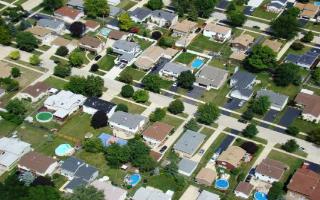
BOSTON, MA - Remember the suburb? It was the shining embodiment of the American dream after World War II, where cheap land met cheap energy, the automobile ruled, and everyone could have a two-car garage. Today, it's where half of the country's population lives. But it's dying.
Just look to the fringes of metropolises in the South and Southwest, where overbuilding and real estate speculation ran rampant, to get a glimpse of what many communities across America could be facing. Large patches of foreclosed homes from Charlotte, North Carolina, to Las Vegas have turned suburban enclaves into derelict districts. Once-thriving malls lie empty, leaving municipalities short on tax revenue and funding for education and services.
Across the country, including Greater Boston, we need to reinvent the suburbs. And with the recent passage of the federal stimulus package and its funding for construction, infrastructure, and energy research, there's no better time to start thinking about this. Here's what the agenda should be in the years ahead:
Be unique. Many suburbs have become indistinguishable from one another. To attract and retain residents, they need to be special. Each suburb has its own strengths, history, landscape, and idiosyncrasies. Why not embrace those qualities and capitalize on them? When I was teaching at MIT a few years ago, my design studio examined a dying mall in Dedham. In looking at aerial photographs of the mall's parking lot, it became clear there was a train line that once ran through the site. Instead of hiding it, the town could build on this trace of history, perhaps convert it into a promenade lined by distinctive row housing. Other suburbs may not have a history to emphasize, but they might have uncommon landscape features. Those aren't hindrances. They're opportunities.
Redefine mobility. Reducing dependence on the car is critical, so suburbs must develop alternatives: more public-transit options, networks for sharing bikes and cars (like Zipcar), and green shuttles - similar to what colleges use to move students within and between campuses. And long-term, try to envision this: greener beltways bounded by solar walls, traffic and cars guided by artificial intelligence, and elevated monorails that ride above Route 128.
Rethink the parking lot. You can reduce the footprint dramatically with hyper-efficient "stack-parking" structures, which have been used effectively from New York to Shanghai. A more elegant approach is tucking the lot inside "bermed" landforms, such as the side of a hill. It's more attractive and, if located next to highways, can shield noise. Also, the conventional mall lot can serve as a solar farm, where paneled canopies generate energy as they shade cars.
Recycle on the biggest scale. Like old mill buildings, dead malls can be converted into a variety of uses: artist space, incubator spaces for start-up businesses, churches, gyms, even housing. Turn them into lush, campuslike settings. That empty Circuit City can become a day-care center, a clinic, or a library, and the facades can be made more energy-efficient, even generating power with solar and wind systems.
Transform housing. Turn single-family houses into more flexible building stock, such as live/work spaces for artists or professionals. A carriage house can become an office for six. McMansions can be converted into multifamily housing or community buildings. Oversized lots can support denser housing, while blocks of foreclosed homes can be converted into satellite campuses for businesses. The key to all this is rewriting zoning practices.
Connect with the neighbors. Strengthen the bonds with adjacent towns and coordinate investments in infrastructure, creating suburban clusters that, in essence, become mini metro areas. Think of a Burlington-Woburn cluster that specializes in high tech and medicine, for example. Or a Braintree-Quincy "node."
Beautify. Create public spaces by converting underused lands and parking lots into parks, plazas, and recreational fields. And weave these together by threading paths through adjacent neighborhoods. We need to take a page from Holland and think of buildings, infrastructure, and landscape as an integrated concept. Vegetation can grow on walls and roofs, blending buildings into the land.
The suburb of the future can be a magnificent place, where machine and garden come together, and where people coexist with nature, not destroy it. Wouldn't you want to live there?
Source: Boston.com